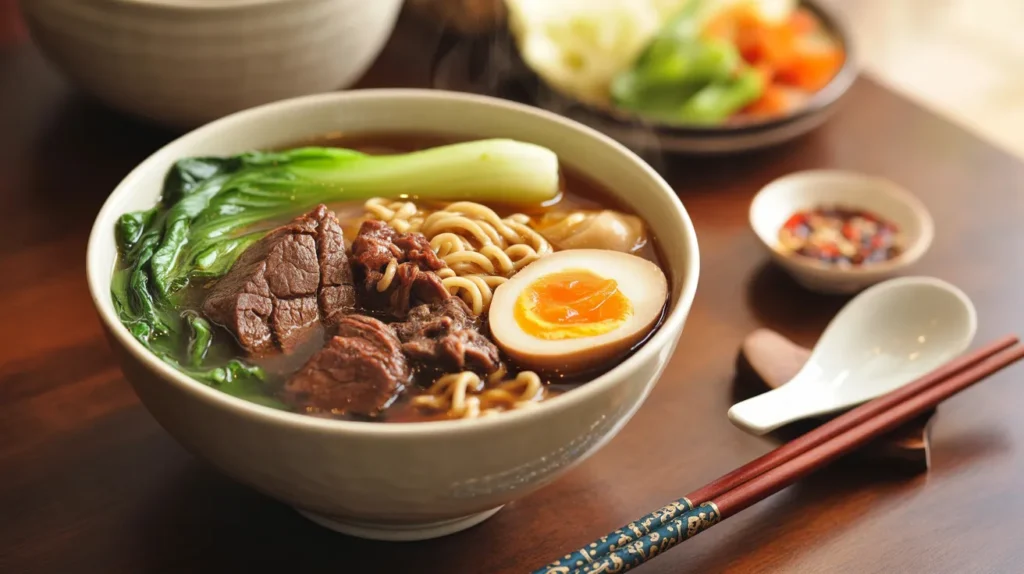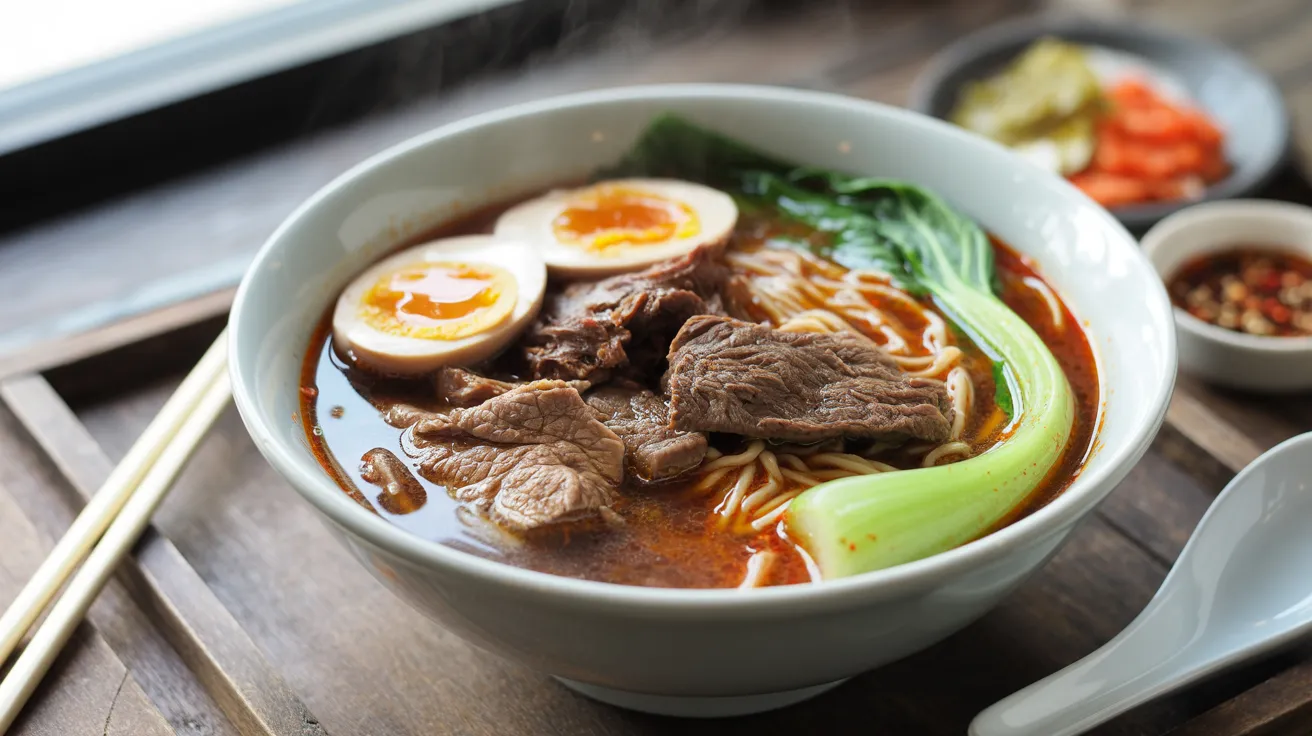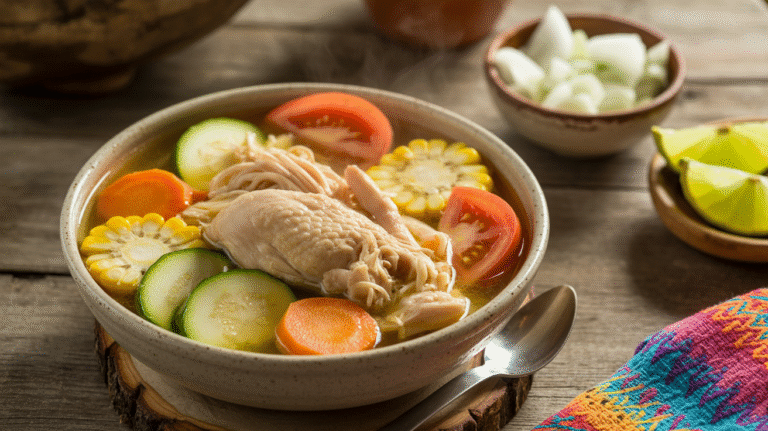This authentic slow-simmered taiwanese beef noodle soup brings the soul-warming flavors of Taiwan’s national dish straight to your kitchen. Rich, aromatic broth mingles with melt-in-your-mouth beef chunks and chewy noodles in this traditional slow-simmered taiwanese beef noodle soup that’s perfect for cozy family dinners and cold winter evenings.
Recipe Info Bar
SERVES: 4 | PREP: 20 MIN | COOK: 3 HOURS 30 MIN | TOTAL: 3 HOURS 50 MIN
Ingredients for Your Slow-Simmered Taiwanese Beef Noodle Soup
For the Beef and Marinade
- 2 lbs beef chuck roast, cut into 2-inch chunks
- 2 tbsp soy sauce
- 1 tbsp Shaoxing wine (or dry sherry)
- 1 tsp cornstarch
For the Aromatic Base
- 3 tbsp vegetable oil
- 1 large onion, sliced thin
- 6 cloves garlic, minced fine
- 2-inch piece fresh ginger, sliced thin
- 3 green onions, chopped (whites and greens separated)
For the Traditional Spice Blend
- 2 star anise pods
- 1 cinnamon stick
- 1 tsp Sichuan peppercorns
- 2 bay leaves
- 1 tbsp doubanjiang (fermented bean paste)
For the Rich Broth
- 6 cups beef stock (low-sodium preferred)
- 3 tbsp dark soy sauce
- 2 tbsp light soy sauce
- 1 tbsp rock sugar (or brown sugar)
- 2 tbsp tomato paste
For Serving Your Slow-Simmered Taiwanese Beef Noodle Soup
- 1 lb fresh wheat noodles (or dried ramen noodles)
- 2 cups baby bok choy, halved lengthwise
- 2 soft-boiled eggs, halved
- Pickled mustard greens for garnish
- Chili oil for serving
Detailed Step-by-Step Instructions
Phase 1: Preparing and Marinating the Beef (15 minutes)
Step 1: Prepare Your Beef Chuck Roast Take your 2-pound beef chuck roast out of the refrigerator 15 minutes before cooking to bring it closer to room temperature. Using a sharp knife, trim any excess fat, leaving some marbling for flavor. Cut the meat against the grain into uniform 2-inch chunks. Why this matters: Cutting against the grain breaks down tough muscle fibers, while uniform pieces ensure even cooking throughout your slow-simmered taiwanese beef noodle soup.
Step 2: Create the Tenderizing Marinade In a large mixing bowl, whisk together 2 tablespoons soy sauce, 1 tablespoon Shaoxing wine, and 1 teaspoon cornstarch until the cornstarch completely dissolves. Beginner tip: If you see white streaks, keep whisking—undissolved cornstarch creates lumpy coating.
Step 3: Marinate the Beef Thoroughly Add your beef chunks to the marinade and use clean hands to massage the mixture into every piece. Make sure each chunk is completely coated. Cover with plastic wrap and let rest for 15 minutes at room temperature. Why this step matters: The cornstarch creates a protective barrier that keeps the beef tender during the long cooking process, while the wine and soy sauce begin breaking down tough fibers.
Phase 2: Building the Aromatic Foundation (20 minutes)
Step 4: Heat Your Dutch Oven Properly Place a heavy-bottomed 6-quart Dutch oven over medium-high heat. Add 3 tablespoons vegetable oil and heat until it shimmers but doesn’t smoke—this takes about 2-3 minutes. Visual cue: The oil should move freely when you tilt the pot, indicating proper temperature for searing.
Step 5: Sear the Beef in Batches Remove beef from marinade, shaking off excess. Working in 2-3 batches to avoid overcrowding, place beef pieces in the hot oil with space between each piece. Sear for 3-4 minutes per side until deep golden brown. Beginner mistake to avoid: Don’t move the beef too early—it should release easily when properly browned. Transfer seared beef to a clean plate and set aside.
Step 6: Cook the Onions Until Caramelized Reduce heat to medium and add your sliced onions to the same pot with all those flavorful browned bits (called fond). Cook for 6-8 minutes, stirring occasionally, until onions become soft and lightly golden. What you’re looking for: The onions should be translucent and starting to caramelize around the edges. This sweetness balances the rich beef flavors in your slow-simmered taiwanese beef noodle soup.
Step 7: Add Garlic and Ginger Carefully Add minced garlic, sliced ginger, and the white parts of green onions to the caramelized onions. Stir constantly for 60-90 seconds until very fragrant. Critical timing: Watch carefully—garlic burns quickly and creates bitter flavors that will ruin your entire dish.
Phase 3: Creating the Spice Base (15 minutes)
Step 8: Toast Whole Spices for Maximum Flavor Add star anise pods, cinnamon stick, Sichuan peppercorns, and bay leaves to the pot. Toast these whole spices for 1-2 minutes, stirring constantly, until you smell their aroma intensifying. Why toasting matters: This technique releases essential oils locked inside whole spices, creating deeper flavor layers in your slow-simmered taiwanese beef noodle soup.
Step 9: Build the Umami Base Push aromatics to one side of the pot and add 1 tablespoon doubanjiang (fermented bean paste) and 2 tablespoons tomato paste to the cleared space. Cook these pastes for 2-3 minutes, stirring constantly, until they darken and become very fragrant. Visual cue: The tomato paste should turn from bright red to deep burgundy. Beginner tip: If you can’t find doubanjiang, substitute with 1 tablespoon miso paste mixed with 1 teaspoon chili garlic sauce.
Step 10: Combine Everything Together Stir the toasted pastes into the aromatics until everything is well combined. Return your seared beef to the pot and toss to coat each piece with the aromatic mixture. Cook for 2-3 minutes, allowing the beef to absorb these complex flavors.
Phase 4: The Slow Simmering Process (3 hours 15 minutes)
Step 11: Add Liquids in the Correct Order Pour in 6 cups beef stock, 3 tablespoons dark soy sauce, 2 tablespoons light soy sauce, and 1 tablespoon rock sugar. The liquid should cover the beef by at least 1 inch. If needed: Add hot water to reach proper level. Stir everything together, scraping up any browned bits from the bottom of the pot.
Step 12: Bring to Proper Simmer Increase heat to medium-high and bring the mixture to a full boil. You’ll see large bubbles breaking the surface. Once boiling, immediately reduce heat to low—the lowest setting on your stove. Target temperature: You want just tiny bubbles occasionally breaking the surface, not a rolling boil.
Step 13: Cover and Begin Long Simmer Place the lid on your Dutch oven, leaving it slightly ajar (about 1/4 inch gap) to allow steam to escape. This prevents the liquid from reducing too quickly. Set a timer for 1 hour for your first check. Why partially covered: Complete covering can cause over-concentration of flavors, while no cover reduces liquid too quickly.
Step 14: Monitor and Adjust During Cooking Check your slow-simmered taiwanese beef noodle soup every hour. The liquid should maintain a gentle simmer with occasional small bubbles. If bubbling too vigorously, reduce heat further. If no movement at all, increase heat slightly. Liquid level check: Add hot water if liquid reduces below the beef level.
Step 15: Test for Perfect Tenderness After 2.5 hours of simmering, test beef tenderness by piercing the largest piece with a fork. It should slide in with no resistance and the beef should easily break apart. If still tough: Continue cooking in 30-minute intervals, testing each time. Some cuts may need up to 4 hours total.
Phase 5: Final Assembly and Serving (20 minutes)
Step 16: Prepare Fresh Noodles Fill a large pot with water and bring to a rolling boil. Cook your fresh wheat noodles according to package directions—usually 2-3 minutes for fresh, 4-5 minutes for dried. Texture goal: Noodles should be tender but still have a slight chew (al dente). Drain immediately and divide among four large serving bowls.
Step 17: Blanch Vegetables Perfectly In the same noodle water, blanch your halved bok choy for exactly 60 seconds until bright green and tender-crisp. Visual cue: The stems should pierce easily with a fork but still have some firmness. Remove with tongs and set aside.
Step 18: Final Seasoning Adjustment Taste your slow-simmered taiwanese beef noodle soup broth and adjust seasoning. Add more soy sauce for saltiness, rock sugar for sweetness, or a splash of black vinegar for acidity. The broth should be rich, slightly sweet, and deeply savory with a beautiful reddish-brown color.
Step 19: Assemble Each Bowl Perfectly Ladle the hot broth and tender beef over the noodles in each bowl, ensuring each person gets equal amounts of beef. Top with blanched bok choy, soft-boiled egg halves, and pickled mustard greens. Serving tip: Warm your bowls with hot water first, then drain—this keeps your slow-simmered taiwanese beef noodle soup hot longer.
Step 20: Final Presentation Sprinkle the green parts of scallions over each bowl and serve immediately with chili oil on the side. Provide chopsticks and soup spoons for the authentic eating experience. Pro tip: Show guests how to mix the chili oil into their broth gradually to taste.
Chef’s Notes for Perfect Slow-Simmered Taiwanese Beef Noodle Soup
Beef Selection: Chuck roast contains perfect marbling and connective tissue that breaks down into gelatin during long cooking, creating the signature silky mouthfeel of authentic slow-simmered taiwanese beef noodle soup.
Spice Balance: Sichuan peppercorns provide the distinctive numbing sensation called “má” that balances rich beef flavors. Start with less if you’re sensitive to heat.
Make-Ahead Strategy: This soup improves overnight as flavors meld. Cool completely before refrigerating, then reheat gently before serving fresh noodles.
Authentic Noodle Choice: Fresh wheat noodles offer the best texture, but dried ramen noodles work as a substitute. Never use thin angel hair—they become mushy.
Nutrition Information (Per Serving)
- Calories: 685
- Protein: 52g
- Carbohydrates: 48g
- Fat: 28g
- Fiber: 4g
- Sodium: 1,240mg
Delicious Variations of Slow-Simmered Taiwanese Beef Noodle Soup
Spicy Sichuan-Style Version
Add 2 tablespoons chili oil and 3-4 dried chilies during the spice-toasting phase for fiery heat that complements the rich broth without overwhelming the beef flavors.
Vegetable-Enhanced Version
Include chunks of daikon radish and carrots during the last hour of simmering. These vegetables absorb the savory broth while adding natural sweetness—similar to how root vegetables enhance old-fashioned beef stew.
Tomato-Forward Style
Double the tomato paste and add fresh tomato wedges for a more pronounced tangy note that’s popular in modern Taiwanese restaurants. This creates a beautiful red-orange broth.
Comfort Soup Collection
For another soul-warming option when you crave different comfort food flavors, try this creamy parmesan Italian sausage ditalini soup that offers Italian-inspired richness.
Storage & Reheating Your Slow-Simmered Taiwanese Beef Noodle Soup
Refrigerator Storage: Cool completely and store broth with beef in airtight containers for up to 4 days. The beef continues absorbing flavors, making leftovers even more delicious than the first serving.
Freezer Storage: Freeze broth and beef (without noodles or vegetables) for up to 3 months. Use freezer-safe containers, leaving 1 inch of headspace for expansion.
Proper Reheating: Thaw frozen soup overnight in refrigerator. Warm gently on stovetop over medium-low heat, stirring occasionally. Add hot water if too thick.
Noodle Storage Rule: Never store cooked noodles with the soup—they become mushy and absorb too much liquid. Always cook fresh noodles for each serving.

Troubleshooting Common Beginner Issues
Problem: Beef Still Tough After Long Cooking
Solution: Some chuck roasts need up to 4 hours to become tender. Continue cooking in 30-minute intervals, ensuring liquid always covers the beef. Temperature may be too high—reduce to barely simmering.
Problem: Bland or Watery Broth
Solution: Remove lid and simmer uncovered for 30 minutes to concentrate flavors. Add more doubanjiang, dark soy sauce, or tomato paste. Season gradually and taste frequently.
Problem: Greasy Surface Layer
Solution: Cool soup overnight and remove the solidified fat layer with a spoon. During cooking, use a ladle to skim fat every hour.
Problem: Noodles Turn Mushy
Solution: Cook noodles separately just before serving. Never add cooked noodles to leftover soup. Fresh noodles should have a slight chew when done.
Problem: Too Salty or Overpowering
Solution: Add rock sugar and unseasoned broth to balance saltiness. The sweetness counteracts excessive salt without diluting other flavors.
Essential Equipment for Slow-Simmered Taiwanese Beef Noodle Soup
- Heavy-bottomed Dutch oven (6-quart minimum for proper heat distribution)
- Sharp chef’s knife for uniform beef cutting
- Large mixing bowls for marinating
- Fine-mesh strainer for removing whole spices before serving
- Ladle for serving broth evenly
- Separate large pot for cooking noodles
- Tongs for handling noodles and vegetables
Organized Shopping List
Meat Counter
- 2 lbs beef chuck roast (ask butcher to cut if needed)
Fresh Produce Section
- 1 large yellow onion
- 1 head fresh garlic
- 2-inch piece fresh ginger
- 3-4 green onions
- 2 cups baby bok choy
- 2 soft-boiled eggs (or ingredients to make them)
Asian Grocery Aisle
- Doubanjiang (fermented bean paste)
- Shaoxing cooking wine
- Dark soy sauce
- Light soy sauce
- Rock sugar (or brown sugar substitute)
- Star anise pods
- Sichuan peppercorns
- Fresh wheat noodles
- Pickled mustard greens
- Chili oil
Pantry Staples
- Vegetable oil
- Cornstarch
- Tomato paste
- Bay leaves
- Cinnamon stick
- Beef stock (low-sodium preferred)
Success Secrets for Perfect Slow-Simmered Taiwanese Beef Noodle Soup
1. Temperature Control is Everything: Maintain barely bubbling liquid throughout the 3+ hour cooking process. Aggressive boiling toughens meat and creates cloudy, greasy broth instead of the clear, rich liquid you want.
2. Layer Flavors at Each Step: Each phase builds complexity—from marinating beef to toasting spices to slow simmering. Skipping steps results in flat, one-dimensional flavor that lacks the depth of authentic slow-simmered taiwanese beef noodle soup.
3. Invest in Quality Base Ingredients: Good doubanjiang, fresh whole spices, and quality beef stock create the foundation flavors. These core ingredients define whether your soup tastes authentic or mediocre.
4. Patience Creates Perfection: Low, slow simmering transforms tough chuck roast into melt-in-your-mouth perfection. Rushing this process with higher heat results in chewy, stringy beef that’s disappointing to eat.
5. Fresh Components Matter: Crisp bok choy, perfectly cooked noodles, runny egg yolks, and tangy pickled vegetables provide essential textural contrast that elevates each spoonful from good to extraordinary.




